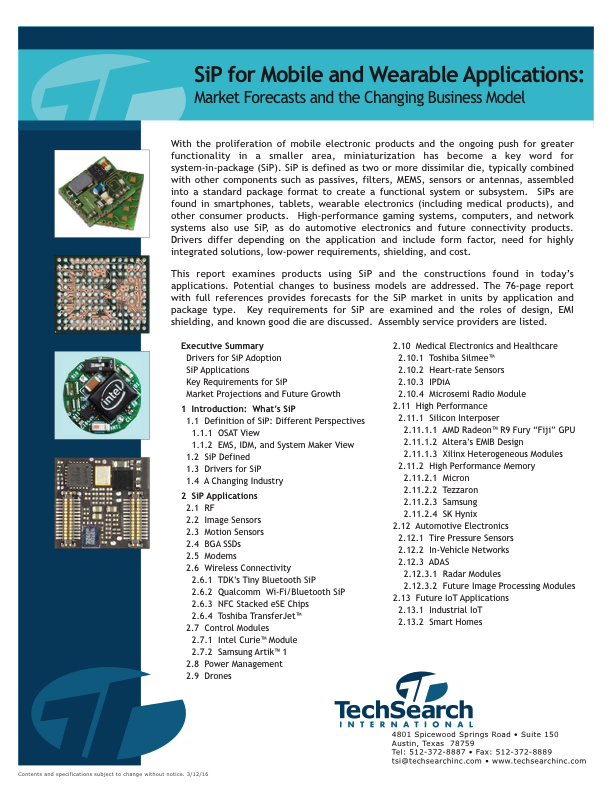- Block Diagram of iPhone 6s
- Apple watch S1 SiP module
- Logic and memory stack in Apple Watch
- Sony's stacked image sensor and logic
- How sensor data fusion works
- InvenSense tri-core 6-axis motion sensor hub
- Integrated BGA SSD compared to eMMC
- TDK's tiny Bluetooth smart SiP with embedded die
- Toshiba TransferJet™ module
- Samsung Artik™ 1
- Samsung Artik™ 1 block diagram
- Marvell's FO-WLP as SiP
- SESUB® power management unit from TDK-EPC
- TI DC/DC converter with AT&S ECP® technology
- TI's PowerStack™ with Cu Clip
- Toshiba Silmee™ vital signs sensor
- Integration density of AFE pseudo-SoC
- Microsemi's SiP
- AMD's Fiji with silicon interposer and HBM
- 5mKGSD package for SK Hynix HBM
Multi-client Reports
SiP for Mobile and Wearable Applications
Market Forecasts and the Changing Business Model
With the proliferation of mobile electronic products and the ongoing push for greater functionality in a smaller area, miniaturization has become a key word for system-in-package (SiP). SiP is defined as two or more dissimilar die, typically combined with other components such as passives, filters, MEMS, sensors or antennas, assembled into a standard package format to create a functional system or subsystem. SiPs are found in smartphones, tablets, wearable electronics (including medical products), and other consumer products. High-performance gaming systems, computers, and network systems also use SiP, as do automotive electronics and future connectivity products. Drivers differ depending on the application and include form factor, need for highly integrated solutions, low-power requirements, shielding, and cost.
This report examines products using SiP and the constructions found in today’s applications. Potential changes to business models are addressed. The 76-page report with full references provides forecasts for the SiP market in units by application and package type. Key requirements for SiP are examined and the roles of design, EMI shielding, and known good die are discussed. Assembly service providers are listed.
A set of PowerPoint slides accompanies the report.
This report examines products using SiP and the constructions found in today’s applications. Potential changes to business models are addressed. The 76-page report with full references provides forecasts for the SiP market in units by application and package type. Key requirements for SiP are examined and the roles of design, EMI shielding, and known good die are discussed. Assembly service providers are listed.
A set of PowerPoint slides accompanies the report.
Who We Are
TechSearch International is recognized around the world as a leading consulting company in the field of advanced semiconductor packaging and assembly, electronics manufacturing, and materials.
Contact
- email message
- +1.512.372.8887
- +1.512.372.8889
- 4801 Spicewood Springs Rd, Ste 150
Austin, TX 78759
United States
Copyright © 2015–2024 TechSearch International, Inc. • techsearchinc.com • all rights reserved


